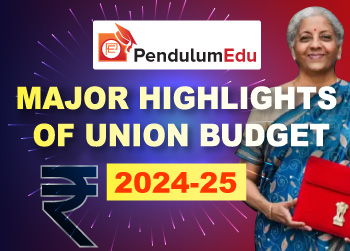Topic: Banking System
1. Bihar, Delhi, and Uttar Pradesh saw the highest increase in average monthly cash withdrawn per ATM in FY25.
- Bihar recorded 8% growth, while Delhi and Uttar Pradesh each saw 4%.
- Himachal Pradesh followed with 3% growth. Chhattisgarh and West Bengal reported 2% growth each.
- Maharashtra and Odisha recorded a 1% increase. Tamil Nadu and Uttarakhand showed no growth in ATM cash withdrawals.
- Several states saw a drop in average cash dispensed per ATM.
- Tripura saw the steepest decline at 23%. Mizoram dropped by 16%, and Kerala by 14%.
- Andhra Pradesh and Goa experienced a 1% fall each.
- In FY24, Delhi, Uttar Pradesh, and Tamil Nadu were among the top cash consumption states.
- The CMS Consumption Report 2025 notes that top consumption regions change yearly.
- Between 2014 and 2024, India's cash economy grew significantly.
- Currency in circulation rose by 157%. The number of ATMs increased by 32%.
- Bank branches expanded by 36%. By April 2023, the currency-to-demand deposits ratio reached about 1.7.
- This is above the long-term average of 1.61 and close to pre-demonetisation levels.
- The ratio had dropped to 0.8 after demonetisation.
- As of March 2024, cash still made up 60% of total consumer spending.
- More households are spending on non-essential and lifestyle products.
Topic: Infrastructure and Energy
2. The share of FDI in India’s renewable energy sector rose from about 1% in FY21 to 8% in FY25.
- This represents a sevenfold increase over five years.
- India is making steady progress toward its target of 500 GW of non-fossil fuel power capacity.
- In the first three quarters of FY25, the sector received $3.4 billion in FDI.
- This amount nearly matched the total FDI of $3.7 billion recorded in FY24.
- Since FY21, the sector has attracted about $12 billion in cumulative FDI.
- The renewable energy share of total FDI rose steadily from 1.3% in FY21 to 8.4% in FY25.
- Meanwhile, the conventional power sector saw a sharp decline in FDI.
- In Q3 FY25, FDI in the power sector dropped to around $125 million.
- India permits 100% FDI in the renewable energy and power sectors through the automatic route.
- According to MNRE, total clean energy investments in the last five years approached ₹4 lakh crore.
- Gujarat and Rajasthan attracted more than half of these investments between 2020 and 2024.
- Together, these two states host over one-third of India’s installed renewable capacity.
- Solar power received the largest share of funding, at ₹2.64 lakh crore.
- This accounts for nearly 66% of total investments in the renewable sector.
- By FY25, India’s total installed power capacity reached 475 GW.
- Renewables accounted for 220.1 GW, while coal contributed 221.8 GW.
Topic: Corporates/Companies
3. Muthoot Microfin has achieved a strong ESG score of 72.2, as evaluated by CARE ESG Ratings.
- It has been awarded the highest rating tier, CareEdgeESG 1, by CARE, a SEBI-authorized ESG rating agency.
- This recognition places the company among the top performers in India’s financial services sector for sustainability.
- Muthoot Microfin has outperformed industry averages across all major ESG areas.
- The rating highlights the company's ability to manage ESG risks effectively.
- It has demonstrated strong performance through transparent disclosures and well-defined policies.
- The company integrates sustainability into its core business strategy.
- It emphasizes ethical governance and responsible financial practices.
- Muthoot Microfin actively supports rural women by providing them with financial access.
- It is also noted for addressing climate risks in its operations.


Topic: Indian Economy/Financial Market
4. On 8 May, Nitin Gadkari said that India has become the third-largest automobile manufacturer.
- Now, India has emerged as the third-largest vehicle manufacturer in the world, according to Union Minister for Road Transport and Highways Nitin Gadkari.
- The announcement was made during the 4th International BBB Summit and Expo on Bioenergy Value Chain held in New Delhi.
- He said that the demand for different types of automobiles is increasing, and at the same time, the consumption of fossil fuels will also increase due to the increase in automobile production.
- A reduction in imports and a boost in exports was emphasized as a key strategy for strengthening the national economy.
- The minister pointed out that agriculture is currently not economically sustainable and proposed that viable solutions must be developed to make it profitable.
- He stressed that self-reliance cannot be achieved without making agriculture financially rewarding.
- He stated that biofuel can enhance farmers' income, reduce pollution, and decrease reliance on fossil fuel imports.
- He highlighted the urgent need to cut India's Rs 22 lakh crore fossil fuel import bill and reduce pollution caused by burning of crop waste and vehicular emissions.
- Gadkari said that now the time has come to convert agricultural waste, crop residue, bamboo and biomass into green fuel and value-added products.
- The two-day summit attended by a wide range of stakeholders, including bureaucrats, scientists, academicians, technocrats, and industry leaders, who are focusing on promoting bioenergy technologies using biomass resources.
Topic: MoUs/Agreements
5. DPIIT and Hafele India signed a partnership agreement on May 7, 2025, in New Delhi.
- The collaboration aims to boost India’s manufacturing and innovation capabilities.
- It focuses on supporting startups, MSMEs, and entrepreneurs.
- The goal is to build strong local supply chains.
- It also seeks to position India as a global manufacturing leader.
- Häfele will lead efforts in product innovation, domestic sourcing, and entrepreneurship.
- These efforts will include funding, mentoring, and access to global markets.
- The company will provide infrastructure support to startups and MSMEs.
- It will also help develop local suppliers and encourage technical collaborations.
- Additionally, Häfele will help these businesses access new markets.
- Häfele has already invested over USD 2.5 million in an Indian appliance startup.
- It has also issued purchase orders to Indian MSMEs in hardware and furniture fittings.
- DPIIT will provide ecosystem support through Startup India.
- This includes networking, program access, and co-branding opportunities.
- Shri Sanjiv, Joint Secretary at DPIIT, said the partnership reflects a strong model of industrial collaboration.
- Frank Schloeder, Managing Director – South Asia at Häfele, praised India’s innovation potential.
- He highlighted the vision of “India for India” today and “India for the World” tomorrow.
- The MoU was signed by Dr. Sumeet Jarangal from DPIIT and Mr. Frank Schloeder from Häfele India.
- The agreement will be effective for two years from the date of signing.
- It may be extended later through mutual agreement.
Topic: MoUs/Agreements
6. India and Chile signed the Terms of Reference (ToR) for a Comprehensive Economic Partnership Agreement (CEPA) on May 8, 2025.
- The agreement signals the beginning of formal CEPA negotiations between the two countries.
- It was signed by H.E. Mr. Juan Angulo, Chile’s Ambassador to India.
- Shri Vimal Anand, Joint Secretary in India’s Department of Commerce, also signed the ToR.
- He is serving as the Chief Negotiator for India in the CEPA discussions.
- The CEPA aims to expand the existing Preferential Trade Agreement (PTA).
- It will include additional sectors such as digital trade, MSME cooperation, investment promotion, and critical minerals.
- The first round of negotiations will take place in New Delhi from May 26 to 30, 2025.
- India and Chile maintain a strong and strategic partnership.
- Their relationship has been strengthened by regular high-level visits.
- In January 2005, the two countries signed a Framework Agreement on Economic Cooperation.
- A Preferential Trade Agreement followed in March 2006.
- This PTA was later expanded in September 2016 and became effective in May 2017.
- In April 2019, both nations agreed to further enhance the PTA.
- To broaden trade ties, both sides decided to begin CEPA talks.
- This decision was based on recommendations from a Joint Study Group (JSG).
- The JSG was established under the 2005 Framework Agreement.
- Its final report was completed and signed on April 30, 2024.
- This commitment was reaffirmed during the Chilean President’s visit to India from April 1 to 5, 2025.
- President Gabriel Boric Font visited at the invitation of Prime Minister Narendra Modi.
- During the visit, both leaders emphasized the role of trade and commerce in bilateral relations.
- They welcomed the signing of the ToR and the launch of CEPA negotiations.
- The CEPA is expected to be a balanced, ambitious, and mutually beneficial agreement.
- It aims to unlock trade and investment potential and support deeper economic ties.
Topic: RBI
7. The Reserve Bank of India has introduced a new framework to streamline the process of making regulations.
- This framework applies to all regulatory documents issued by the Reserve Bank of India, including guidelines, orders, and policies.
- Under the new process, the Reserve Bank of India must publish draft regulations on its official website.
- The publication must include a detailed explanation of the regulation.
- This explanation should outline the regulation’s objectives and, when possible, an impact assessment.
- It must also refer to global standards and best practices, if applicable.
- The RBI will invite public feedback, providing at least 21 days for comments.
- After reviewing the feedback, the Reserve Bank of India must publish a summary of responses.
- The final version of the regulation must also be posted on the website.
- This process will be followed for any amendments to existing regulations.
- The Reserve Bank of India must regularly assess whether current regulations remain relevant.
- This review will consider supervision outcomes, global practices, and any redundant provisions.
Topic: Banking/Financial/Govt Schemes
8. The Cabinet Committee on Economic Affairs has approved an updated version of the SHAKTI Policy for coal distribution to the power sector.
- The new policy introduces two coal linkage options: Window-I for coal at the official price and Window-II for coal at a premium above the official price.
- Window-I will continue the current system for providing coal linkages to Central Sector Thermal Power Plants and States.
- States can use their allocated coal linkages for their own generating companies or Independent Power Producers (IPPs).
- This can be done through competitive bidding or existing Power Purchase Agreements (PPAs).
- Window-II allows coal-based power producers, including those using imported coal, to acquire coal through auction.
- Power plants in Window-II have the flexibility to sell the generated electricity as needed.
- The implementation of the revised policy will be handled by Coal India Limited (CIL) and Singareni Collieries Company Limited (SCCL).
- The new policy simplifies coal allocation by reducing the previous eight guidelines to just two main windows.
- The requirement for a Power Purchase Agreement (PPA) has been removed for coal obtained through Window-II.
- This change provides more flexibility to power plants.
- Imported Coal Based (ICB) plants can access domestic coal through Window-II.
- The revised policy promotes the establishment of new thermal power projects at pithead locations, closer to coal sources.
- The rationalization of coal sources will help reduce the cost of coal at thermal power plants.
- Minor adjustments to the policy can be made by the concerned ministries.
- Existing Fuel Supply Agreement (FSA) holders can acquire coal beyond their contracted quantities under Window-II.
- Surplus coal from these linkages can be sold in the power market.
- The policy benefits thermal power plants, railways, Coal India Limited, Singareni Collieries Company Limited, state governments, and electricity consumers.
- SHAKTI (Scheme for Harnessing and Allocating Koyala Transparently in India) Policy:
- The SHAKTI Policy, introduced in 2017, shifted coal allocation from a nomination-based system to a transparent auction method.
- It was refined in 2019 and 2023, with this latest revision simplifying the allocation process.


 Previous
Previous 
 Latest
Latest 








Comments